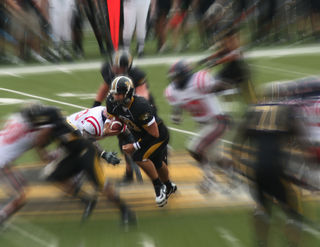Traumatic Brain Injury
When a Concussion Is Not a Concussion
Don't confuse these conditions with symptoms that mimic concussions.
Posted September 18, 2014 Reviewed by Jessica Schrader

With the dizzying array of news about sports concussions and related symptoms, we may be at risk of misinterpreting symptoms that appear to be due to a concussion. However, it is common for an athlete to experience signs and symptoms that mimic concussions but are due to other conditions.
Here are some conditions with symptoms that mimic or can be confused with concussion injury. Remember concussions are a mild brain trauma affecting the physiology of the brain. The conditions below may stand alone, or occur simultaneously with concussion or post-concussion syndrome.
Heat Exhaustion/Dehydration. Many sports begin with practice in the summer months, and in regions where ambient temperatures on the field may be in the 90s or more. If athletes in these environments do not drink enough water before, during and after the session, then heat exhaustion or dehydration may result. The heat alone may have adverse effects on brain function leading to symptoms such as fainting (loss of consciousness), dizziness, confusion, nausea, vomiting, even convulsions. These symptoms could easily be mistaken for concussion.
Extra Cranial (outside the skull) Soft Tissue Trauma. The head often suffers injury to the tissues outside the skull, particularly in non-helmeted sports. Bruises, lacerations and other traumatic injury to these tissues are often associated with pain. Attentive care should be taken to address the wound, but be careful not to refer to the pain as a “headache” even though the head may ache.
Occipital Neuritis. A neurological condition often confused with migraines, occipital neuritis involves a pair of nerves at the back of the head below the skull that wrap upwards and around the back of the head to supply sensation to these regions. Injuries that involve "whiplash" movement or rotational forces may stretch and injure these nerves causing inflammation and nerve pain known as neuralgia. This pain is usually sharp, stabbing and radiates up the back of the head, or can be dull and aching. Often there is "referred pain" (pain perceived at a location other than the site that received the injury) that is felt behind one or both eyes.
Migraine. Migraine is a common condition occurring equally in about 6 percent of pre-teen boys and girls. After the onset of adolescence, the incidence of migraine climbs to about 18 percent in young women while remaining at around 6 percent in men. Migraines run in families. The migraine brain is an irritable brain, with unstable physiology and reactivity to many internal and environmental factors, including head trauma. There is significant evidence that having a personal or family history of migraine make one more vulnerable to concussion injury. The flipside of the coin is that head trauma may serve as a triggering factor for migraines even in individuals who have never had a migraine. Care must be taken not to label a new migraine condition as persistent post-concussion syndrome.
TMJ. This is just a variation of the extra-cranial soft tissue injury mentioned above. TMJ stands for Temporo-mandibular Joint, which is the joint between the jaw and the skull. Trauma to the jaw can result in stretching injury and inflammation to the ligaments that hold these joints together. Malocclusion (misalignment of the teeth) by dislocation of the jaw can lead to further inflammation and pain in these regions often mistaken as “headache."
Benign Positional Vertigo. The inner ear is the balance organ that tells the brain how you are situated in space, sensing acceleration and movement. Through a complex structure of tubes filled with liquid and crystals known as otoliths, the inner ear functions much like a carpenter's level. Traumatic forces to the head can lead to displacement of the otoliths in one or both ears. This results in misinformation of balance to the brain and results in vertigo. The vertigo is typically brief, lasting seconds and less than a minute, but recurrent, brought on by further movement of the head. Recognition of this condition is very important because it is usually very easily treated with head rolling exercises such as Eppley or Sermont maneuvers.
Analgesic Overuse Headache. Also known as a "rebound headache,” this is a well-known phenomenon amongst headache specialists whereby a medication is used to treat a headache disorder (traumatic or otherwise) and the chronic use of this medication leads to a new headache pattern that would not have happened if the medication was not used. These are usually milder, more diffuse headaches with a chronic daily pattern, typically not associated with nausea, light or sound sensitivity, or provoked by exertion.
Reactive Psychological Issues. Once concussed, life changes dramatically for the athlete. This person who has dedicated his life to physical activity is now told to go to physical and mental rest. School and work are missed. He may start falling behind in his obligations. The athlete's social structure may dramatically change. He may feel that he is letting his team, coaches, and family down by not being able to participate in his sport. These stressors may contribute to depressed mood, worry, and anger apart from the physiological changes in the brain.
Reactive Sleep Issues. Similarly, because the injured athlete is at rest, with low levels of arousal, and may be sleeping during the day, or because of the emotional reactions described above, difficulty sleeping at night may occur. Nighttime sleep deprivation may in turn lead to daytime sleepiness and a vicious cycle of disturbed sleep ensues.
Cervical Strain/Sprain. Any time there is a head injury, trauma to the neck and spine must be considered. These injuries include strain and sprain of the muscles of the neck and ligaments associated with the spine. Fractures and dislocation of the vertebrae of the spine may also occur. These conditions can lead to headaches, and even vertigo, without direct injury to the brain.
Orthostatic Hypotension/Tachycardia. A rare condition that may occur after a head injury is post-traumatic orthostatic hypotension/tachycardia. This condition occurs when the blood pressure drops (hypotension) or the heart rate increases (tachycardia) abnormally when going from a lying to a standing position. Profound changes in these vital signs can lead to light-headedness and even fainting. Low-grade postural changes in these vitals can lead to a sense of chronic fatigue.
I believe concussions are emerging as a new field of science, somewhere between neurology and sports medicine. As research continues to unfold the concussion mystery, the more we understand them and respect their dangers, the better we can provide recommendations for managing them within the context of sports. Concussions are receiving their moment in the spotlight, and for good reason. But be careful not to confuse other conditions with symptoms that appear to be concussion-related.
Cognitive neurologist Harry Kerasidis is the founder of Chesapeake Neurology Associates in Maryland and XLNTbrain LLC, and the medical director for the Center for Neuroscience, Sleep Disorders Center and Stroke Center at Calvert Memorial Hospital.




